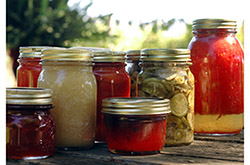
There’s nothing like a meal featuring vegetables you grew and nurtured in your garden. Enjoy your homegrown produce all year long by canning, freezing or drying produce when it’s plentiful.
Each preservation method has its own pros and cons.
“In making a decision about how to preserve your food, consider the equipment required, the preparation and processing times, the nutrient value of the foods and the convenience of preparation for you after the food has been preserved,” says Tammy Roberts, a University of Missouri Extension nutrition and health education specialist.
Canning
The process of canning heats foods to temperatures that inactivate enzymes and destroy microorganisms that could cause illness or food spoilage.
Heat during the canning process forces air out of the jar, and a vacuum seal is formed as the jar cools. This seal prevents air, which can contain microorganisms, from getting back into the food.
Boiling water canning is recommended only for jams, jellies, fruit, tomatoes and pickles. All other vegetables, meat and poultry should be processed in a pressure canner.
Pressure canning does cause some loss of vitamins and minerals, due to the high levels of heat it uses. Some of the vitamins and minerals are lost in the fluid within the jar, so using the fluid helps assure you receive the food’s maximum nutrient value.
Freezing
Freezing foods stops the growth of microorganisms, but does not destroy them.
Enzymes are proteins produced by the cell of the plant. One thing enzymes are responsible for is the maturation of the plant’s fruit. Enzymes must be inactivated before foods are frozen to prevent undesirable changes in flavor, color and texture.
You can achieve this by blanching for a specified amount of time. If done correctly, this preservation process assures maximum nutrient retention in the food.
Drying
Drying is among the oldest methods of food preservation. The process of drying removes the moisture from the food so that microorganisms cannot grow and spoil the food.
Some common dried foods include jerky, fruit leathers and fruit pieces.
The only equipment you need to dry these and other foods is a dehydrator or an oven. Vitamins A and C can be lost in this process but there is a process called sulfuring to help prevent the vitamin loss.
Foods preserved by drying are lightweight and don’t need much storage space.
For a hands-on learning experience, find a food preservation workshop in your area using MU Extension events.
Article originally posted at Southwest Region News Blog.